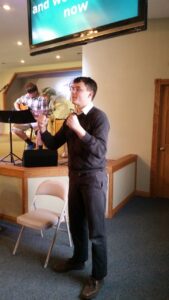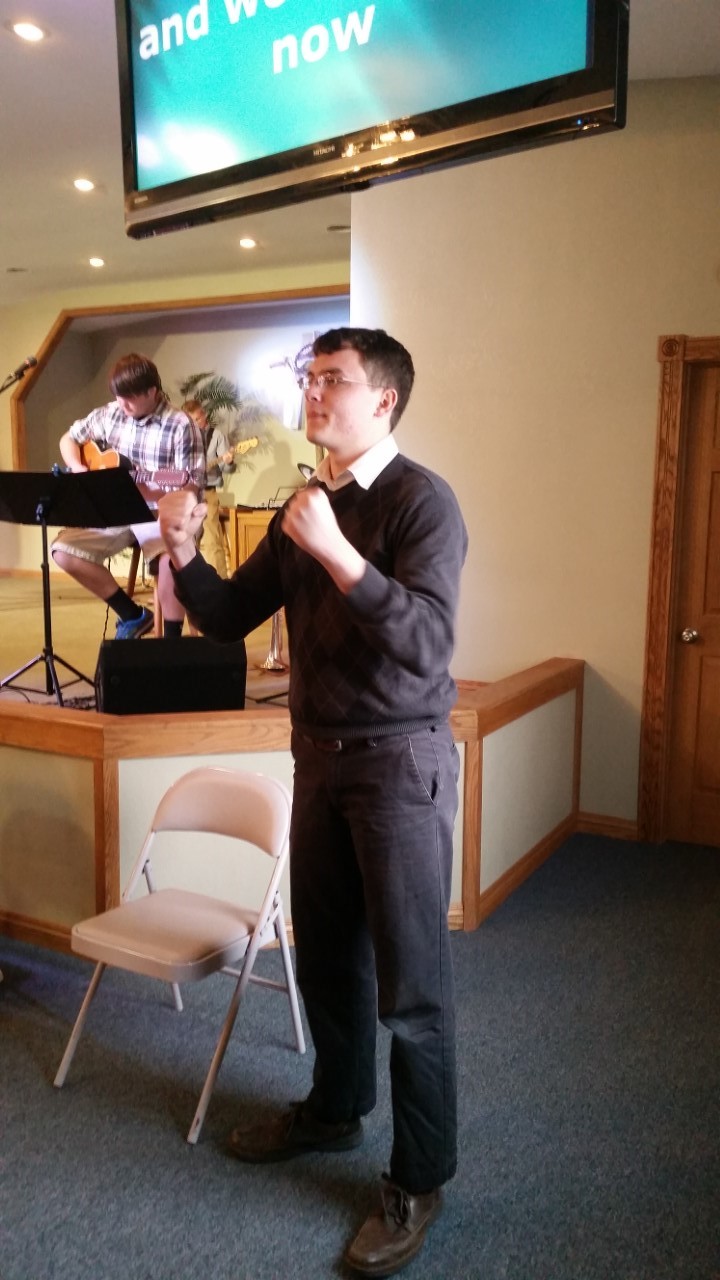
Senior Daniel Slonim and junior William Persson can say plenty without making a sound.
Slonim interprets songs and sometimes sermons at Pine Ridge Bible Church in Quincy, Michigan, on Sundays, and Persson formerly interpreted his high school’s theater productions in Minnesota. Those experiences, they said, allowed them to access a community they wouldn’t have otherwise.
Slonim learned ASL with his family using websites, computer programs, and a formal class at a deaf school after the deaf mother of a member of his church began attending.
Although she passed away several years ago, Slonim said she taught him perseverance.
“She had such a positive attitude,” Slonim said. “She expressed so much joy through all of that.”
That perseverance he learned from her shows through as Slonim grows in his ability to interpret at Pine Ridge, where he came for the first time during his sophomore year. Slonim saw Laura Loveberry, who has interpreted at Pine Ridge for 20 years, signing for Dale and Elaine Miller in the front pew.
Slonim went right up to the group to introduce himself. Loveberry said she was impressed.
“Most people are a little bit afraid to talk to someone who is deaf,” Loveberry said. “It was a brave and bold and awesome thing to do, because a lot of people in the deaf community feel like people don’t want to approach them because they don’t know what to say.”
It didn’t take long before Loverberry was urging Slonim to try interpreting. He started with signing songs and said he was thankful that the Millers were so patient with him.
“Anything is better than nothing,” Slonim said. “I just pray God will help me to get the message through, and whatever I do, I hope it’s not terrible heresy.”
Since then, Slonim said he has grown in his ability to interpret. He normally does the songs at services, but sometimes he signs the sermons, too.
Loveberry said she appreciates Slonim’s assistance and their ability to tag team on the interpreting during church service.
“He’s been an encouragement to me,” Loveberry said. “When you are signing for a sermon and songs, that is totally focusing for an hour and a half. When you’re done, you’re exhausted.”
Since Slonim is a senior, Loveberry said she will miss having him to share the job of interpreting at the service.
“You’re giving the person a visual picture of the song, and he’s able to get into the music of the song,” she said. “He has a heart for service and a love for God. We’re literally being the hands and feet of Jesus by getting the message to them.”
For that, Dale Miller said he appreciates the ministry Daniel has done over the past three years.
“He’s been growing and growing and improving and improving,” Miller said. “He shares my language.”
Persson said he enjoys serving the deaf community by interpreting, as well. While attending Minnetonka High School, Persson decided to stop studying Spanish and tried his hands at sign language instead.
“I just jumped into it,” Persson said. “I had always wondered what it would be like.”
Persson said he excelled rapidly at his courses, and his teachers were soon helping him to learn to interpret. With one other student, Persson became involved with his high school’s theater department as a junior, and they would interpret the plays and musicals together.
“The theater productions are open to all deaf people at any time,” Persson said, adding that since he has left, students have continued to interpret the shows. “They’d come up and talk to you afterward. They were always so thankful because it’s not very typical.”
Persson said his experiences with interpreting and speaking to deaf people taught him about the isolation and even prejudices that come with being unable to hear.
“You can tell they really struggled with that, and it changed them a bit,” Persson said. “I learned to be more respectful of them and those who are learning English.”
Now at Hillsdale, Persson said he continues to practice ASL to make sure he doesn’t lose it, but there are not many places to use the skill while at college.
“It was really nice being a volunteer in that community,” Persson said. “It’s something I miss here.”
Nevertheless, Persson said he hopes to get involved with using ASL after graduation.
Persson and Slonim agreed that learning and knowing sign language can allow people to have access to those who speak the sixth most popular language in the United States.
“Why learn Latin? That has value in and of itself,” Persson said. “But this one has value because there is this community, and you can’t understand their community as well without the language.”
Slonim said he appreciated the visual aspect of it, adding that people normally talk with their hands.
“Talking with your hands and having it mean something is pretty cool,” Slonim said.
Persson said he likes the emotion that sign language can capture.
“I admire how beautiful it can be,” Persson said. “You can see their joy so much more evidently because it’s very different from English. It’s all about the way you express your body in all sorts of shapes.”
Slonim said that animation allows you to be more expressive than using English, since you can’t make some facial expressions when forming words.
“To be able to express something that’s not in words,” Slonim said, “it frees you.”

